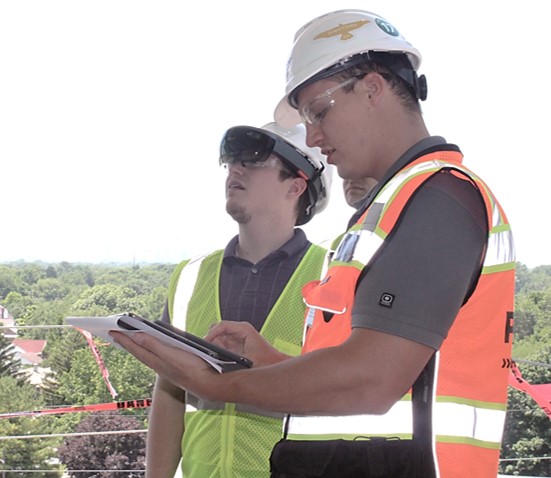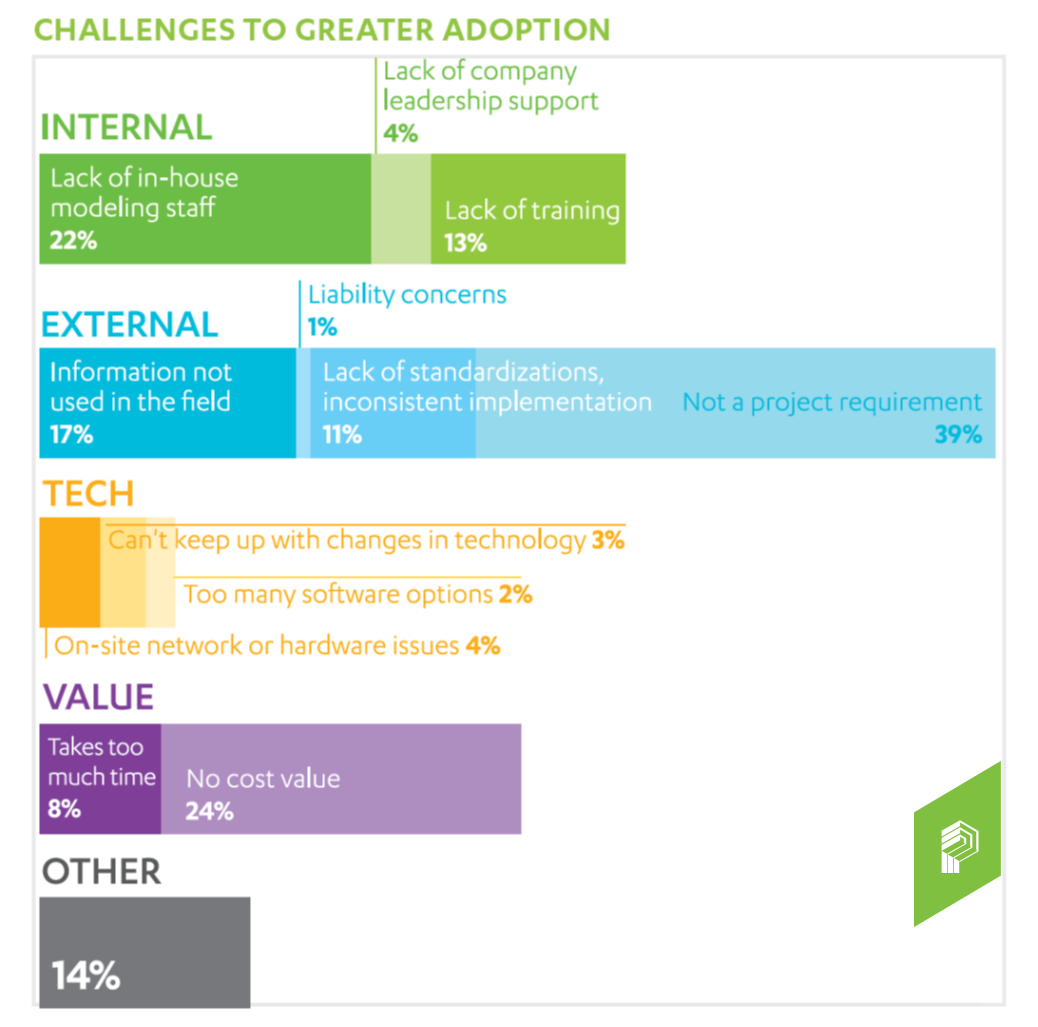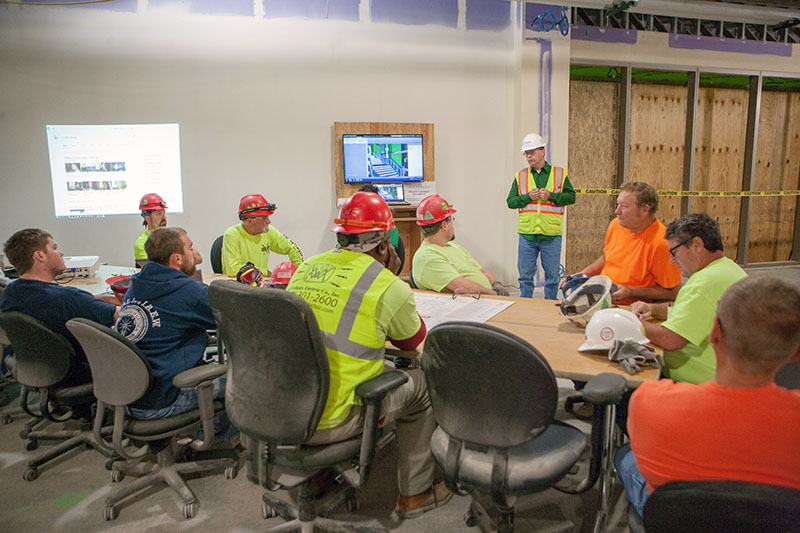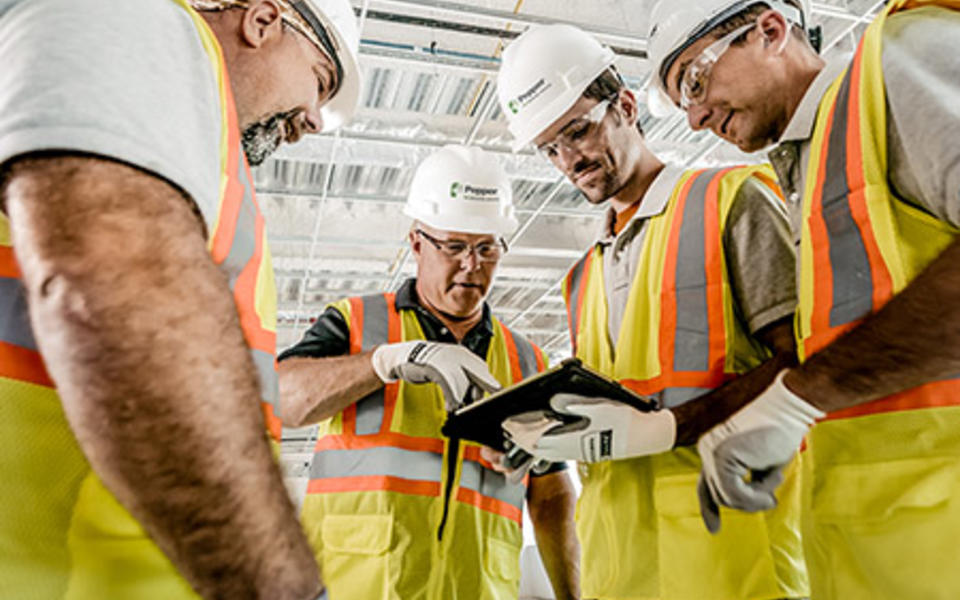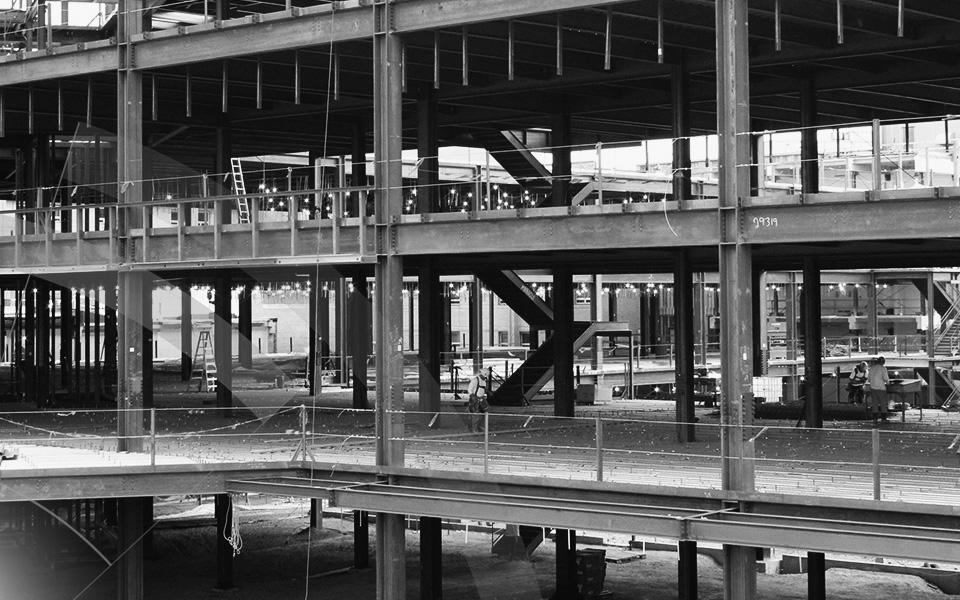Virtual construction & technology, Trade partnerships
Understanding how our trade partners use technology and what it will take for more to experience the value of BIM
From the accessibility of plans on mobile devices to real-time estimating and drone inspections, technology plays an increasingly important role on our projects. Thanks to our use of technology, this year we've captured topographical data of a large portion of a zoo in a couple hours, reduced underground utility strikes on our job sites and constructed a net zero trailer with the plans projected in front of our eyes.
Despite industry-leading applications like these, the rate of technology adoption is growing at a slow rate. National industry publications like ENR have surveyed general contractors and large trade partners about their use of BIM, and they report a majority are using BIM. It's encouraging news… but we wondered why we weren't seeing that level of commitment on our projects. We agreed the use of technology has grown, but we didn't feel like it had reached the level of the majority - at least not in the Midwest.
Regional versus national perspective
This past October, we conducted our second trade partner survey to better understand how they use technology. (The first one was conducted in 2016.) Our initial reason for doing so was to get a closer pulse on the trades with whom we work and compare our findings with the national surveys. After sharing our findings with others in the industry and hearing their responses, we realized our research represented a more realistic picture of the current state of adoption when spread across projects and partners of all sizes and when focused on the Midwest region.
We conducted a second survey this year to see if the needle had moved, and we asked additional questions to dig deeper into the motives and challenges our trade partners face. This second survey again reiterated what we have been seeing. The adoption of technology is on the rise, but at a slower pace than we would like to see. In 2016, the number one reason people used BIM was "project requirement." Today -- well, it's still the number one reason. However, the number who use BIM because of the value it brings went up from 33 percent to 50 percent. The chart below shows how tech adoption has improved over the past two years.
Why focus on BIM?
While some of the initial questions were about technology in general, most of the questions we asked were specific to BIM. For the trades who don't use BIM, they questioned the structure of the survey and suggested they weren't qualified to respond.
At Pepper, our approach is model-centric, meaning we use and evolve a 3D model from preconstruction through project completion. Additionally, each of our team members - estimating, safety, quality, high performance, MEP, project management and field supervision - uses the same model as the source of information for the project.
We understand not every trade contributes equally to the model or has the same need for it. However, consider that over the past 20 years, technology has been an integral part of the solution to the following hypothetical questions:
- What if we could design in 3D?
- What if we could eliminate clashes between systems before installation?
- What if we could update the estimate and the drawings at the same time - and in real-time?
- What if we could see underground utilities before we dig?
- What if we could see the plans in front of us as we build?
Asking these questions and others have led to breakthroughs in how we plan and construct buildings as an industry. Further, the answers to these specific questions all come back to BIM.
Finally, we're seeing more and more owners request information about using BIM for facility management (FM). With client interest increasing, it's important that we complete the cycle and figure out how to bridge the data and communication gaps to provide owners with information in a format they can use - and that means engaging the trades in the process. We can't hand over a solution that works without our trade partners' involvement.
Why include all trades?
In our survey, we included all scopes of work and all size companies because to get an accurate picture of the perception and use of BIM in our market, we needed an accurate representation of all trades. Whether or not they realize it, BIM affects all trades. It could be that the data one contractor is asked to provide benefits another more than themselves. We've found this to be the case in many instances. The goal of BIM is to look at the project as a whole and not in terms of individual scope. As the construction manager, it's important that we understand which trades benefit the most and enable others to see the value their piece brings to the entire project - so we can enable their success as well.
Additionally, through this survey and through our projects, we've also learned from our partners how some use BIM to their advantage. We didn't initially anticipate them finding value in the technology, and their answers surprised us.
What did we find?
There were many findings; however, following are 5 key takeaways:
-
The number one reason for using BIM is still project requirement over value offered. We've moved the needle in a positive direction, but there's still ample room to improve. A company isn't likely to see the value until they’ve experienced it. Making it a project requirement creates the circumstances for this, and our hope is that it will cause companies to implement it more in the future, whether it’s a project requirement or not. We want our teams to use and invest in technology because of the value it provides, particularly if we want to cause industry change.
-
The rate of adoption for technology has gone up - but not as much as we would like to see. The current response shows the value is not spread across our partners and is only seen in certain trades right now. Education and value proposition are key. The more we educate and consistently require all trades to use technology, the more they will understand the value and eventually develop the resources to provide BIM on projects. A trade won’t (and shouldn’t) just hire someone to hire someone. They need to see and understand the value, while also having the need and demand for BIM on projects.
-
Responsiveness from diverse partners was low. Given the lack of diversity in our industry, this was not surprising. While there is a big focus on reaching out to these partners to achieve participation levels on our projects, we need to also be educating and guiding them on the latest technology. That's what it means to be a true partner. It’s a benefit to their companies and our projects. As follow up to this survey, we are currently planning round table discussions around this topic, as well as exploring the creation of a training seminar to help our partners get started.
-
Investing in in-house BIM coordinators and skill sets has not changed much, and it was identified as a top 3 challenge to using BIM or using BIM more. As I talk with different trades, this aligns with the feedback I hear. It's less about the desire to hire and more about the lack of qualified candidates. I've seen this myself, as Pepper grows our group and seeks candidates who understand the intricacies involved in using the technology and how to best apply it to construction. It's a conversation I have often with our trade partners, as we are always trading ideas for how to find qualified people. If our industry was more consistent in how and when we use BIM, I think we would start to see the skill sets improve too.
- Few trades provide BIM for Facility Management (FM). Of those who have, they aren't confident the data is being used. I wrote an article on BIM for FM a couple weeks ago, as we've seen an increase in inquiries from owners. The survey findings were timely because even the most committed trades acknowledged the industry isn't there yet. But we are on our way and have seen very successful programs, albeit few and far between. We need to educate our partners on how the technology is being leveraged by owners, as well as work with our owners to better understand the value BIM can bring to them and make sure that information gets communicated to our trade partners.
What else can we do to increase adoption?
In addition to educating our industry – from our trade partners to owners, there are other actions we can take to help our partners experience the value of technology:
- GCs must lead. As general contractors, we can find ways to apply the technology more consistently so our trades know how to apply it from one project to the next – and better set them up for success. We should be taking a leadership role in managing the model and making decisions instead of coordinating our trade partners' models and relying on them for our BIM solutions. Knowing that some produce models for themselves regardless of project requirement, we should also be requesting the model more often, even when it's not a requirement for us.
- ANALYZE WHAT WORKS AND WHAT DOESN'T. Trades should analyze and establish thresholds or standards for when it makes sense to use BIM – essentially a Go/No Go approach. Hopefully, the formal analysis would show them the value. And it would also help us understand as an industry what expectations we should have and when it makes most sense to implement technology requirements. The trades' own understanding could push more consistency from the bottom, up.
- Enforce implementation of BIM within teams. Particularly from planning to the field. If teams fully embraced the model, the trades would see the benefits. One of the biggest challenges to adoption and most frequent comments we received was the lack of follow-through by the entire team, and particularly by the field. It's an interesting perspective considering I think the field has the most to gain. When we have superintendents who embrace technology – even seeking out what’s next – that's when we see the biggest return. How can we get that message to all our field leadership? It's a question we're working on ourselves.
Conclusion
BIM is poised to be a differentiator, except that the adoption has been inconsistent even among general contractors. To implement it consistently and efficiently and get everyone on board will require a paradigm shift that hasn't yet happened. We have to think about construction in a completely different way – from shifting resources and staff more toward the beginning of the project, to developing a commitment to each other – viewing the technology from the perspective of the project as a whole and not just individual scope – and driving the cost value to all partners.
Where do we go from here? For us, the survey results left several questions for which we intend to follow up – and particularly with our diverse partners and those who were not as represented in the survey. I mentioned round tables, forums and training, which would allow us to dive deeper and engage partners on a more personal level. And hopefully, this time next year our survey results will show an even higher rate of adoption because of the value our partners are experiencing.
Thanks to all of our trade partners who participated in the survey. If you you are interested in participating in future surveys like this, please let us know.
To download a summary copy of the survey findings, click here. A white paper with all findings will be available upon request in the Spring, after we complete some additional follow-up research and action steps.
About the Author



